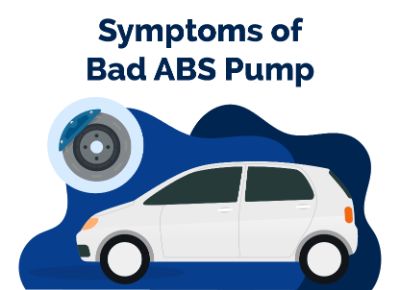8 Common Symptoms of a Bad ABS Pump
February 22, 2023


I am a serial entrepreneur and a consumer advocate. When I’m not helping car buyers, I love working on ventures that have a positive impact.
I run a cause marketing agency and serve on the board of Vayu Global Health where we are disrupting the medical industry and preventing the needless deaths of mothers and babies during childbirth.
The Anti-lock Braking System (ABS) is an important safety feature in modern cars. The ABS stops the wheels from locking up during hard braking and keeps you in control of your vehicle.
A malfunctioning ABS pump can lead to brake problems, so it's important to be aware of the symptoms of a bad ABS pump.
This article will discuss the common symptoms of a bad ABS pump and how to diagnose the issue.
We'll also cover what you can do to get your ABS pump back up and running. At the end of this article, you should better understand the various signs of a faulty ABS pump and what steps to take if you suspect a malfunctioning ABS pump.
Table of Contents
- Bad ABS Module Symptoms Video
- What is an ABS Pump?
- Symptoms of a Bad ABS Pump
- 1. The ABS Light is Illuminated on the Dashboard
- 2. Brakes Become Difficult to Modulate
- 3. Strange Noises Coming from the ABS Pump
- 4. Brakes Not Working Properly
- 5. Vehicle Pulling to One Side When Braking
- 6. ABS Pump Runs Continuously
- 7. Brake Pedal Feels Spongy or Unresponsive
- 8. ABS Pump Motor Runs but Does Not Activate
- How to Diagnose a Bad ABS Pump
- 1. Check the ABS Light on the Dashboard
- 2. Test the Brake Pedal for Sponginess or Unresponsiveness
- 3. Listen for Strange Noises Coming from the ABS Pump
- 4. Check for Uneven Brake Pressure Distribution
- 5. Inspect the Wiring and Relays of the ABS Pump
- 6. Test the ABS Pump Motor
- 7. Inspect the Solenoid Valve of the ABS Pump
- 8. Perform a Diagnostic Scan of the ABS System
- How to Fix a Bad ABS Pump
- Can you Drive with a Bad ABS Pump?
- ABS Pump Replacement Cost
- Benefits of Fixing Your Bad ABS Pump
- Best Car Deals by Category
Bad ABS Module Symptoms Video
What is an ABS Pump?
The Anti-lock Braking System (ABS) is a safety feature in most modern cars. The ABS stops the wheels from locking up during sudden braking, allowing the driver to maintain control of the vehicle.
This is accomplished by the ABS pump, which combines an electric pump, accumulator, and valves.
The ABS pump works with the other components of the ABS to detect when the brakes are applied and to adjust and release brake pressure as necessary.
Symptoms of a Bad ABS Pump
A malfunctioning ABS pump can cause several different symptoms, the most common being:
1. The ABS Light is Illuminated on the Dashboard
This is the most obvious symptom of a bad ABS pump. The ABS light is usually located on the dashboard and will be illuminated when the ABS detects a malfunction.
It's essential to have your vehicle inspected by a qualified mechanic if the ABS light is illuminated.
2. Brakes Become Difficult to Modulate
A malfunctioning ABS pump can make the brakes difficult to modulate, meaning that the brakes become too sensitive or too hard to control.
If you find it difficult to modulate the brakes, it's a sign that your ABS pump may be malfunctioning, and it's essential to have it inspected by a qualified mechanic.
3. Strange Noises Coming from the ABS Pump
A malfunctioning ABS pump can cause strange noises, such as grinding or squealing, coming from the pump.
If you hear any strange noises emanating from the ABS pump, it's important to have it inspected by a qualified mechanic to determine the cause of the noise.
4. Brakes Not Working Properly
A malfunctioning ABS pump can cause the brakes not to work properly. If you observe that the brakes are not working as expected, it's likely that the ABS pump is malfunctioning and needs to be inspected.
5. Vehicle Pulling to One Side When Braking
If the ABS pump malfunctions, the vehicle may pull to one side when braking. The uneven brake pressure distribution causes this due to the malfunctioning ABS pump.
If you observe your vehicle pulling to one side when braking, it's important to have the ABS pump inspected.
6. ABS Pump Runs Continuously
If the ABS pump is malfunctioning, it may run continuously, even after the brakes have been released.
This can be caused by a faulty solenoid valve, which needs to be replaced to fix the issue.
7. Brake Pedal Feels Spongy or Unresponsive
A malfunctioning ABS pump can cause the brake pedal to feel spongy or unresponsive.
The uneven brake pressure distribution causes this due to the malfunctioning ABS pump. If the brake pedal feels spongy or unresponsive, it's important to inspect the ABS pump.
8. ABS Pump Motor Runs but Does Not Activate
If the ABS pump motor is running but not activating, it is likely due to a faulty relay or a bad wiring connection. This issue needs to be inspected and repaired by a qualified mechanic.
How to Diagnose a Bad ABS Pump
To successfully diagnose a bad ABS pump, take the following steps:
1. Check the ABS Light on the Dashboard
The ABS light on the dashboard will be illuminated if the ABS detects a malfunction.
This is usually the first indication that the ABS pump may malfunction, so it's essential to have your vehicle looked at by a qualified mechanic if the ABS light is illuminated.
2. Test the Brake Pedal for Sponginess or Unresponsiveness
A malfunctioning ABS pump can cause the brake pedal to feel spongy or unresponsive.
The uneven brake pressure distribution causes this due to the malfunctioning ABS pump. If the brake pedal feels spongy or unresponsive, it's important to inspect the ABS pump.
3. Listen for Strange Noises Coming from the ABS Pump
A malfunctioning ABS pump can cause strange noises, such as grinding or squealing, coming from the pump.
If you hear any strange noises emanating from the ABS pump, it's important to have it inspected by a qualified mechanic to determine the cause of the noise.
4. Check for Uneven Brake Pressure Distribution
If the ABS pump malfunctions, the vehicle can pull to one side when braking. The uneven brake pressure distribution causes this due to the malfunctioning ABS pump.
If you observe your vehicle pulling to one side when braking, it's important to have the ABS pump inspected.
5. Inspect the Wiring and Relays of the ABS Pump
If the ABS pump motor is running but not activating, it is likely due to a faulty relay or a bad wiring connection. This issue needs to be inspected and repaired by a qualified mechanic.
6. Test the ABS Pump Motor
The ABS pump motor needs to be tested to determine if it is functioning properly. This can be done by a qualified mechanic using a diagnostic scan tool.
7. Inspect the Solenoid Valve of the ABS Pump
If the ABS pump is running continuously, it may be due to a bad solenoid valve. This issue needs to be inspected and repaired by a qualified mechanic.
8. Perform a Diagnostic Scan of the ABS System
A diagnostic scan of the ABS can help to identify any issues with the ABS pump. This should be done by a qualified mechanic using a diagnostic scan tool.
How to Fix a Bad ABS Pump
1. Replace Any Faulty Components
If the ABS is unable to work properly, the components of the system must be replaced.
A qualified mechanic can do this. Some of these include the ABS pump, the solenoid valve, and the accumulator.
2. Re-Calibrate the ABS System
After installing the new components, the ABS should be re-calibrated using a diagnostic scan tool. A qualified mechanic should perform this step using an ABS scan tool.
3. Replace the ABS Pump
If the ABS pump is failing, you must replace the component. This can be done by a mechanic who is familiar with the system.
4. Repair Any Wiring or Relays
Check the wiring and relays of the ABS pump. If the vehicle is still not responding to the ABS pump, it could be due to a faulty relay or a wiring issue.
5. Replace Any Damaged Accumulator
The brake pressure can be released and stored in the ABS if the accumulator is damaged. A qualified mechanic should replace this component if it is damaged.
6. Replace Any Damaged Valves
The valves of the ABS are responsible for controlling the brake pressure. If any of the valves are damaged, they need to be replaced. A qualified mechanic should do this.
7. Replace Any Worn or Damaged Brake Pads
The brake pads of an ABS are required to be in good condition to work properly. If the pads are damaged or worn, they need to be replaced by a mechanic.
8. Replace the Brake Fluid
The brake fluid should be in good condition to ensure that the ABS operates properly. If the brake fluid is low or contaminated, it must be replaced.
Can you Drive with a Bad ABS Pump?
No, it is not safe to drive with a bad ABS pump. The ABS is an important safety feature, and a malfunctioning ABS pump can cause brake problems, which can be dangerous.
If you suspect your ABS pump is malfunctioning, it’s important to have it inspected and repaired by a qualified mechanic.
ABS Pump Replacement Cost
The cost of replacing an ABS pump will vary depending on the vehicle's make and model and the damage's extent. It's best to consult a qualified mechanic for an accurate estimate.
Benefits of Fixing Your Bad ABS Pump
- Improved Braking Performance: A functioning ABS pump will help to ensure that your brakes are working effectively, providing you with improved braking performance.
- Improved Vehicle Safety: The ABS is an important safety feature, and a functioning ABS pump will help to keep you safe while driving.
- Reduced Wear and Tear: A functioning ABS pump will help to reduce the amount of wear and tear on your brakes, extending their life and saving you money.
- Improved Fuel Economy: A functioning ABS pump will help to improve the fuel economy of your vehicle, as the brakes will work more efficiently.
- Peace of Mind: Knowing that your brakes are functioning properly and your vehicle is safe to drive will provide you with peace of mind.
Best Car Deals by Category
Posted in Car Buying Tips, Car Troubleshooting |




